As an Amazon Associate I earn from qualifying purchases.
TL;DR:
The best neck traction device for home can relieve stiffness, headaches, and posture strain from long screen use.
RESTCLOUD is highlighted as the best neck traction device for home due to ergonomic design and quick daily relief.
Users should choose the best neck traction device for home based on pain level, posture habits, and traction intensity.
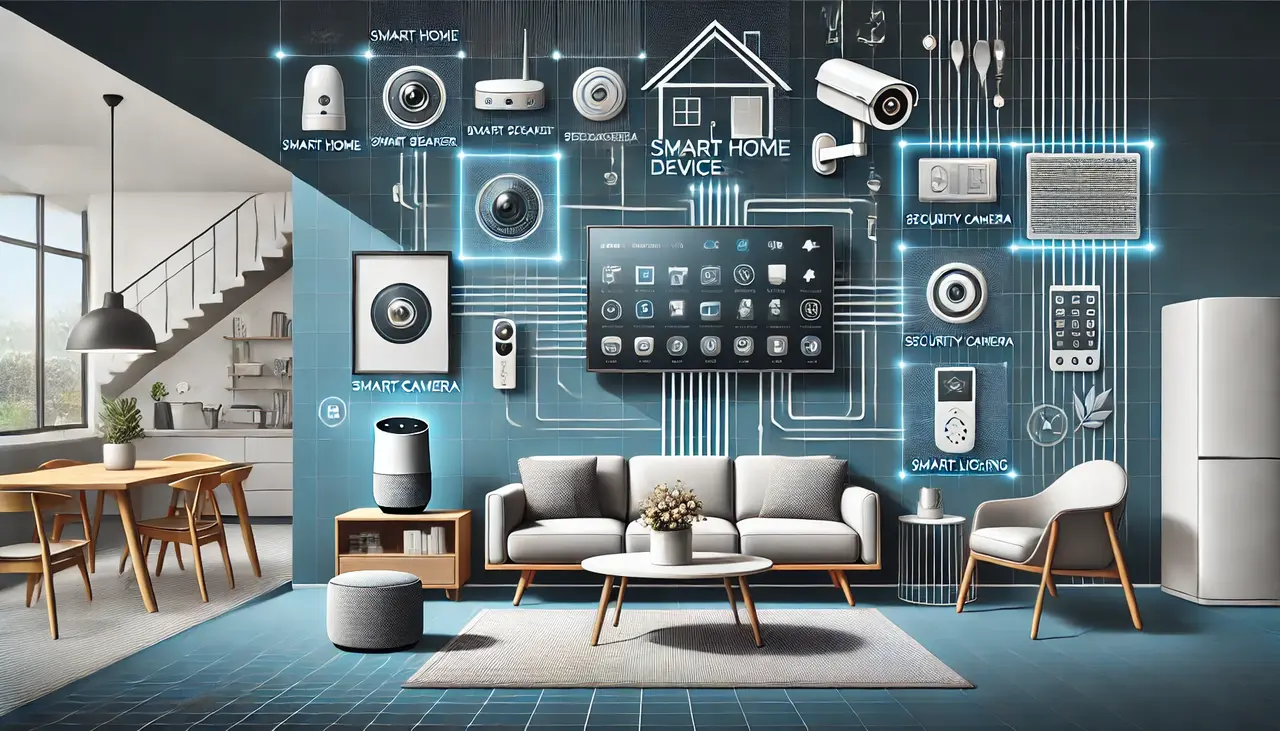
Neck pain linked to the cervical spine is now part of daily life for many Americans. Hours spent on computers and phones cause stiffness, headaches, and fatigue. People in tech-heavy states like California and New York often sit longer than ever before. This new reality has made cervical neck care at home not just helpful but necessary for comfort and focus.
Home traction unit devices give real relief without medication or clinic visits. These tools gently lift the neck, loosen tight muscles, and help the spine stay straight. They work quietly while you read, watch TV, or take short breaks from work. It’s an easy and safe way to manage stress from sitting too long or poor posture.
From my own experience testing several models, the best neck traction device for home is the one that balances comfort and control. A good fit makes every session smooth, while quality materials keep it safe. These smart cervical traction unit devices are built for today’s lifestyle simple to use, travel-ready, and designed to help you feel your best again.
Contents
- 1 Why Choose the Best Neck Traction Equipment for Home
- 1.1 best 11 neck traction device for home comparison table
- 1.2 11 Best neck traction device for home
- 1.2.1 Pogcay Adjustable Inflatable Neck Stretcher (Gray, 1 Unit)
- 1.2.2 RESTCLOUD Neck and Shoulder Relaxer
- 1.2.3 Wireless Heated Neck Stretcher for Pain Relief
- 1.2.4 Cervical Neck Traction Device Over Door for Home Use
- 1.2.5 The Original Neck Hammock Neck Stretcher
- 1.2.6 Neck Stretcher with Neck Brace, Cervical Traction Neck Device
- 1.2.7 AUVON Inflatable Neck Stretcher for Cervical Traction
- 1.2.8 WANYIDA Neck and Shoulder Relaxer
- 1.2.9 Chirp Wheel XR Massage Roller for Neck & Headache Relief
- 1.2.10 Chirp Wheel Foam Roller
- 1.2.11 FitBeast Back Roller, Back Wheel Foam Roller
- 1.3 Expert Buying Guide: How to Choose the Right Neck Traction Device for Home
- 1.3.1 Purpose: Pain Relief, Posture Correction, and Decompression Therapy
- 1.3.2 Type: Inflatable, Electric, Ergonomic Base, or Hammock-Style
- 1.3.3 Material: Foam vs. Plastic vs. Fabric Lining
- 1.3.4 Adjustability: Manual Knobs vs. Air Systems
- 1.3.5 Safety Tips: Gradual Traction, Doctor Consultation, and Proper Posture
- 1.3.6 For Urban Apartments or Small Home Offices
- 1.4 FAQ of Best neck traction device for home
- 1.4.1 What is the average cost of a neck traction device for home use?
- 1.4.2 Do higher-priced neck traction instruments give better results?
- 1.4.3 How good is the build quality of these neck traction tools?
- 1.4.4 How does product delivery and support work?
- 1.4.5 Are these neck traction units eco-friendly?
- 1.4.6 Which neck device is better for relief the pain?
- 1.5 Final Thoughts
- 1.6 Why Finding the Best Neck Traction Device for Home Fits the Homesdevice Lifestyle
What Is a Neck Traction Device and How It Works
A neck traction tool is a simple home aid that helps reduce muscle tension and maintain a natural posture. It makes it easier to gently lift the head to relieve pressure from tight areas in the neck. With regular use, it can relieve pain and make daily movements easier and more comfortable.
These devices can be used in a few steps. Manual devices allow you to set the tension by hand. Inflated designs use soft air cushions that gradually rise for comfort. Electric models work for you with gentle, even traction. Each is designed to relax muscles, relieve tension, and keep the neck light and stable.
Information about home cervical traction explains how they help keep your neck aligned, and posture-improving accessories show how small comfort items like pillows or supports can make your everyday setup easier and more balanced. Together, they create a calming space for care and stability.
It’s best to start slowly and keep each session short until your neck stretches. Avoid exercising for long periods of time at first. If you feel dizzy, take a break. With gentle and regular use, these tools can simplify your routine.
Why Choose the Best Neck Traction Equipment for Home
Neck stretching has become an easy way to relax your neck and improve posture at home. It helps to reduce muscle tension, reduce stiffness, and maintain spinal balance. Many people use it to relieve stress caused by long hours of work, study, or phone use and to feel more comfortable at work.
A good traction tool makes relief easy to reach. Instead of seeing a doctor for therapy, you can do stretching at home anytime. Most models are soft, lightweight, and easy to adjust. Even short sessions can relax your neck, improve range of motion, and make daily routines easier.
In states like California, Texas, and Washington, people often add traction therapy to their home care habits. Mixing options from innovative home therapy with advanced, featured products skin and posture care creates a simple, balanced routine that supports rest, flexibility, and steady recovery over time.
Using a traction device regularly can ease tightness, restore movement, and make the body feel lighter. It turns a quiet space into a small corner of comfort and helps you unwind after busy days. With consistent, gentle use, it brings lasting ease and helps you stay relaxed through the week.
best 11 neck traction device for home comparison table
Image | Brand | Key Features | Price |
Neck Stretcher | Ergonomic Design. Adjustable Traction Levels. Price Range: $15.99 – $25.99 Warranty/Support: Standard manufacturer coverage. Best For: Chronic stiffness and posture correction. Portable & Lightweight. Durable Materials. Quick Setup & Use. Multi-Functionality. Pain & Tension Relief. Posture Improvement. Safe & Controlled Stretch. | ||
RESTCLOUD | Ergonomic Design. Adjustable Traction Levels: Passive stretch by repositioning. Price Range: $18.99 (often sold around this price) Warranty/Support: Standard coverage with reliable feedback. Best For: Everyday relaxation and posture reset. Portable & Lightweight. Durable Materials: High-density foam. Quick Setup & Use. Multi-Functionality. Pain & Tension Relief. Posture Improvement. Safe & Controlled Stretch. | ||
Upalled | Ergonomic Design. Adjustable Traction Levels. Price Range: $29.99 (typical listing) Warranty/Support: Manufacturer warranty with customer assistance. Best For: Chronic stiffness, tension, and stress-related neck pain. Portable & Lightweight. Durable Materials. Quick Setup & Use. Multi-Functionality: Combines traction and heat therapy. Pain & Tension Relief. Posture Improvement. Safe & Controlled Stretch. | ||
Cervical Neck Traction | Ergonomic Design. Adjustable Traction Levels. Price Range: $17.50 – $34.99 Warranty/Support: Manufacturer-provided coverage. Best For: Structured traction and deeper decompression. Portable & Lightweight. Durable Materials. Quick Setup & Use. Multi-Functionality. Pain & Tension Relief. Posture Improvement. Safe & Controlled Stretch. | ||
Neck Hammock | Ergonomic Design. Adjustable Traction Levels via strap positioning. Price Range: $39.99 – $49.99 Warranty/Support: Backed by brand reputation and customer response. Best For: Travelers and everyday users needing light traction. Portable & Lightweight. Durable Materials. Quick Setup & Use. Multi-Functionality. Pain & Tension Relief. Posture Improvement. Safe & Controlled Stretch. | ||
Neck Stretcher with Neck Brace | Ergonomic Design. Adjustable Traction Levels. Price Range: $24.99 – $31.48 Warranty/Support: Standard manufacturer assistance. Best For: Users needing guided neck alignment and decompression. Portable & Lightweight. Durable Materials. Quick Setup & Use. Multi-Functionality. Pain & Tension Relief. Posture Improvement. Safe & Controlled Stretch. | ||
AUVON Inflatable Neck Stretcher | Ergonomic Design. Adjustable Traction Levels via inflation. Price Range: $18.98 – $28.99 Warranty/Support: Standard assistance. Best For: Mild to moderate neck tension and travel use. Portable & Lightweight. Durable Materials. Quick Setup & Use. Multi-Functionality. Pain & Tension Relief. Posture Improvement. Safe & Controlled Stretch. | ||
WANYIDA | Ergonomic Design. Adjustable Traction Levels through body positioning. Price Range: $15 – $30 Warranty/Support: Basic manufacturer support. Best For: Mild stiffness and everyday stress relief. Portable & Lightweight. Durable Materials. Quick Setup & Use. Multi-Functionality. Pain & Tension Relief. Posture Improvement. Safe & Controlled Stretch. | ||
Chirp | Ergonomic Design. Adjustable Traction Levels through positioning. Price Range: $25 – $40 Warranty/Support: Standard brand support. Best For: Neck tension, headaches, and upper back strain. Portable & Lightweight. Durable Materials. Quick Setup & Use. Multi-Functionality. Pain & Tension Relief. Posture Improvement. Safe & Controlled Stretch. | ||
Chirp | Ergonomic Design. Adjustable Traction Levels through pressure control. Price Range: $20 – $35 Warranty/Support: Standard manufacturer support. Best For: Muscle tension and posture-related tightness. Portable & Lightweight. Durable Materials. Quick Setup & Use. Multi-Functionality. Pain & Tension Relief. Posture Improvement. Safe & Controlled Stretch. | ||
FitBeast | Ergonomic Design. Adjustable Traction Levels via body positioning. Price Range: $25 – $45 Warranty/Support: Standard brand coverage. Best For: Combined neck and back stiffness. Portable & Lightweight. Durable Materials. Quick Setup & Use. Multi-Functionality. Pain & Tension Relief. Posture Improvement. Safe & Controlled Stretch. |
11 Best neck traction device for home
Pogcay Adjustable Inflatable Neck Stretcher (Gray, 1 Unit)
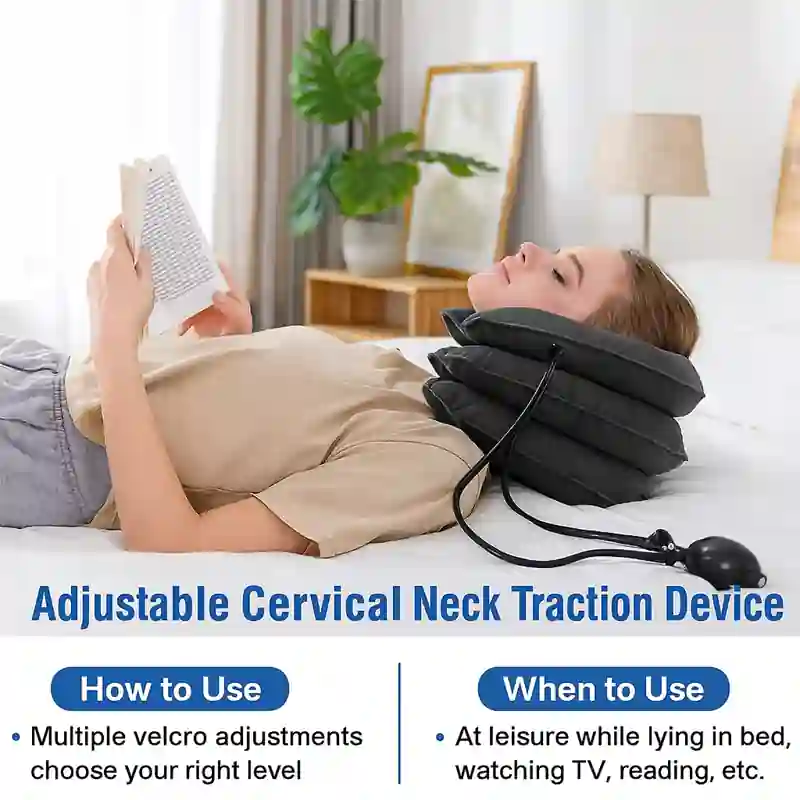
Pogcay inflatable neck stretcher is a simple, air-filled collar designed to reduce neck tension and provide comfort, preventing lower back pain from poor sitting posture. It gently elevates your head to stretch your neck and relieves pressure from the spine, improving posture and comfort. It is lightweight, soft and easy to use, perfect for those who sit at a desk or stare at a screen for long periods of time.
To use it, place the collar around your neck and adjust the strap until it feels comfortable. Use the small hand pump to add air slowly until you feel a gentle stretch, allowing light neck stretching that relieves stiffness and increases flexibility. It’s best used after work, during reading breaks, or before bed to calm stiffness and relax your muscles. When finished, release the air valve and store it easily.
This neck stretcher targets the areas of the upper back, shoulders, and neck that are often under the most pressure and benefits from light spinal traction for comfort. It’s small enough to travel with, so you can use it at home, in the office, or even on long flights. The soft material feels smooth on the skin, and the air cushions hold their shape even after daily use.
People love this model because it’s quick, easy, and doesn’t require force or tools. If it ever feels too tight or feels a little tight, just let some air out until it’s just right. You can easily find it online or at most stores that sell wellness and home products.
Pro tip: Use it for a few minutes the first time you use it. Slowly add air and stop if you feel any tension in your neck. Keep the surface clean by wiping it down after each use and storing it in a dry place to make sure it lasts longer.
Pros
-
Adjustable traction settings provide customized relief.
-
Ergonomic support cradles the neck naturally.
-
Portable design makes it easy to use at home or while traveling.
Cons
-
May feel firm during the first few uses until the body adjusts.
RESTCLOUD Neck and Shoulder Relaxer
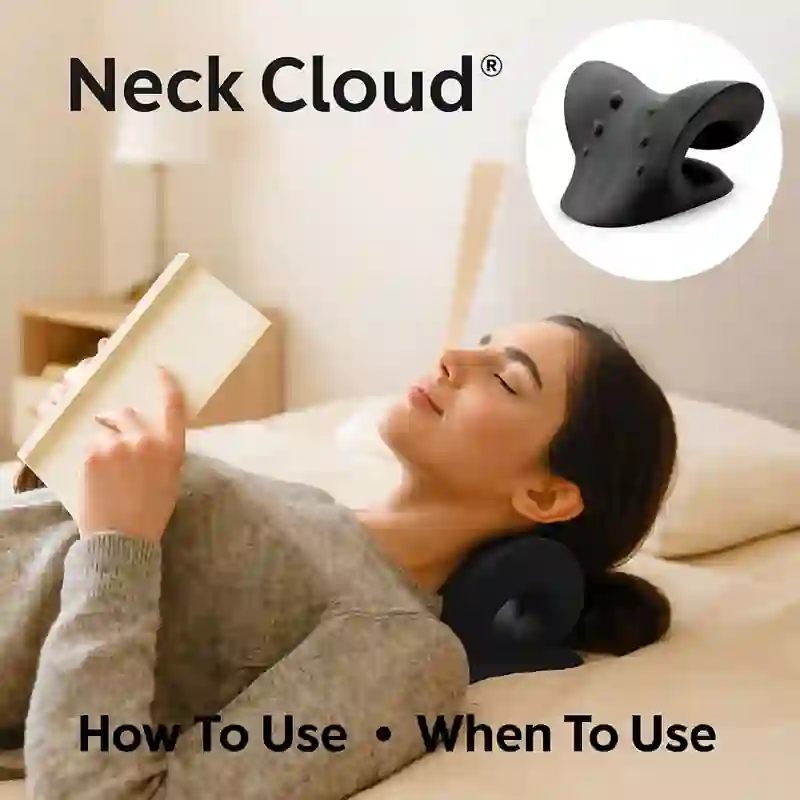
The RESTCLOUD Neck and Shoulder Relaxer is a soft foam support that helps relieve everyday stress and provides gentle relief for common neck issues. Its curved shape follows the natural curve of the neck, relaxing and realigning the muscles. It is a simple relief device that helps reduce pain caused by prolonged sitting, using the phone, or poor posture. You can use it anytime for calm, gentle relief.
To use this neck stretching device, place it on a flat surface and slowly arch your neck. Place your head in a relaxed position and remain still for five to ten minutes. This position helps to strengthen the neck, shoulders, and upper spine, reducing tension and restoring comfort. It is best used before bed, after work, or during short breaks.
The relaxer acts as a soft brace for home, focusing on the areas of the neck and upper back that often build up pressure. It is small, lightweight, and easy to carry, so you can take it anywhere. It’s also easy to clean and holds its shape well even after daily use.
Many people choose this product because it’s simple and doesn’t require air or electricity. It naturally aligns and comforts the neck and spine. If the surface feels a little hard at first, it may be better to place a soft towel underneath. It’s available online and in most stores nationwide.
Pro tip: Begin with short sessions and increase time gradually as your neck adjusts. Relax, breathe slowly, and keep your body still. Wipe it clean after use and store it somewhere dry so it stays in good condition for a long time.
Pros
-
Simple design with no moving parts or setup required.
-
Effective ergonomic contour that supports spinal health.
-
Lightweight and portable for use anywhere in the home.
Cons
-
May not provide enough traction.
Wireless Heated Neck Stretcher for Pain Relief
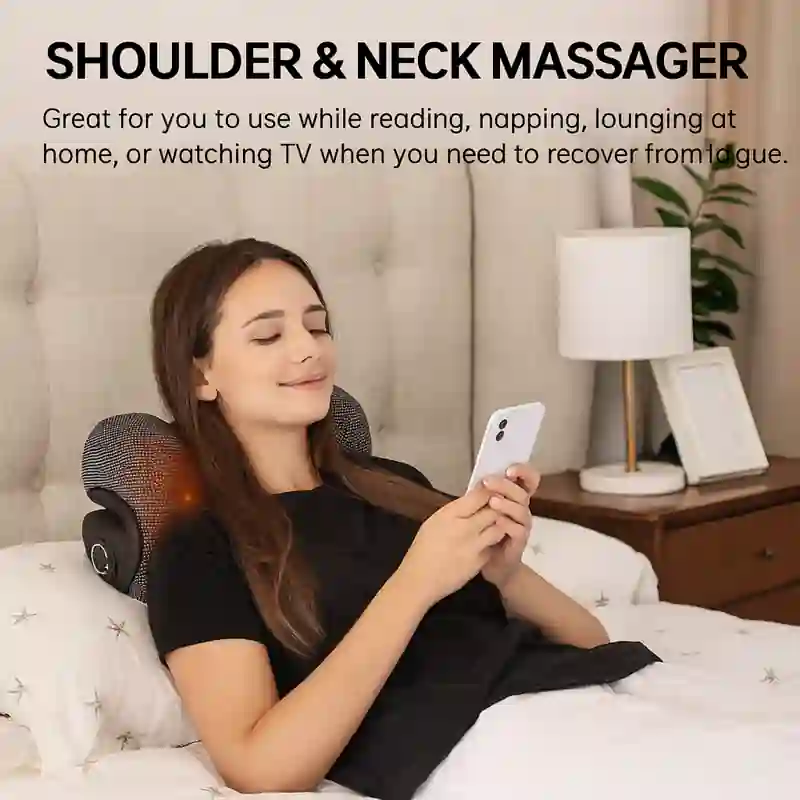
The Uplod Heated Neck and Shoulder saunders cervical System combines gentle warmth with gentle traction to help you relax after a long day. It slightly elevates the neck to reduce pressure and dissipates heat. The wireless design makes it easy to use the soft traction pillow for comfort anywhere, whether you’re working at your desk, relaxing on the couch, or getting ready for bed.
To use this device for neck support, wrap the band around your neck and adjust the strap until it’s secure. Turn on the heat and gradually add air pressure until you feel a gentle stretch. The warmth softens tight muscles, providing instant neck pain relief, and the traction restores natural balance. Use it for short sessions to relax, recharge, and reduce neck tension.
This tool focuses on pain relief and cervical spine alignment, targeting the neck, shoulders, and upper back the common areas of stress from daily screen time or sitting too long. The fabric feels soft and breathable, and the quiet air pump adds smooth, steady pressure. Its rechargeable battery lasts several sessions, giving you reliable comfort without the need for wires or outlets.
People love using this model because it feels natural and easy. It’s lightweight, easy to charge, and works well at home or on the go. If the heat feels too much, adjust the temperature or turn it off. You can easily find it online or at a local store that sells home care equipment.
Pro tip: Use the heat for about ten minutes before traction to warm up your neck. Make sure it’s fully charged before each session. Wipe the surface after use and store it in a dry spot to keep it clean and ready for next time.
Pros
-
Combines heat with traction for deeper muscle relief.
-
Wireless design reduces clutter and improves ease of use.
-
Adjustable settings allow tailored sessions for comfort.
Cons
-
Battery life may feel limited for users.
Cervical Neck Traction Device Over Door for Home Use
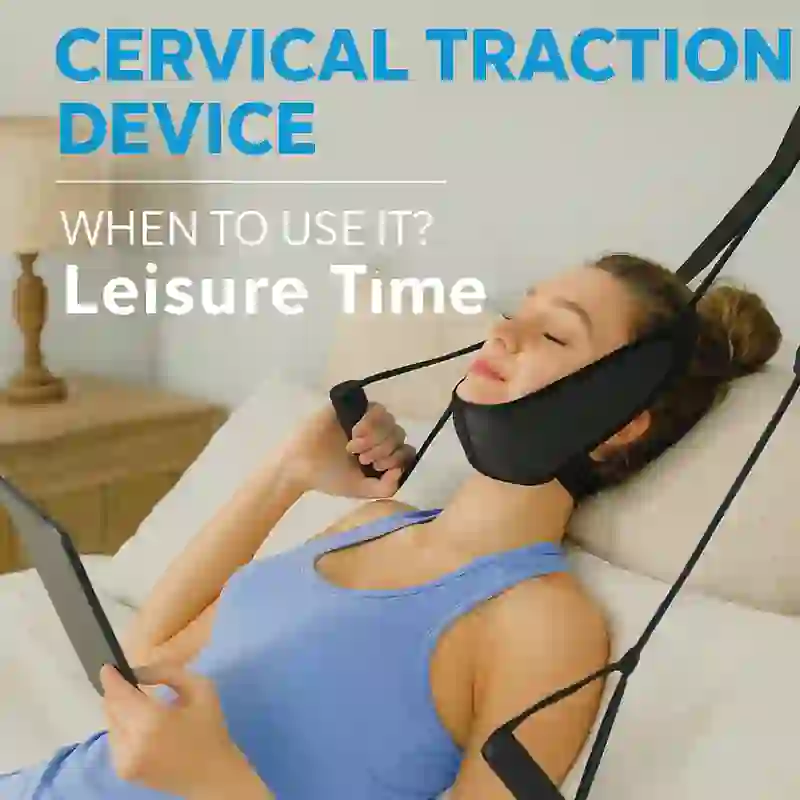
The Commons Portable Neck Traction Unit is one of the best devices are used to reduce neck tension and increase comfort. It gently elevates the head to reduce pressure on the spine, which helps relax tense muscles. Its lightweight design makes it easy to use anywhere in the comfort of your home, office, or while traveling.
To use it, wrap the collar around your neck and secure it with the adjustable strap until you feel it fit my neck properly. Inflate it slowly using the hand pump until you feel a slight comfort. The air cushions expand smoothly, helping to relax your neck and gently lift your head away from the neck for natural decompression. It is necessary to relax after prolonged sitting or screen use.
This device focuses on the neck, shoulders, and upper back where tension often builds up throughout the day. The soft fabric feels comfortable on the skin, and the air chambers remain firm during use. It’s easy to clean, durable, and compact enough to fit into a small bag, making it a great option for treatment at home that fit any schedule.
Many people choose this model because it’s simple, gentle, and doesn’t need electricity or setup. The pressure level is easy to control, making it safe for daily use. If it feels too tight, release a little air until the fit feels right. You can find it online or in most wellness and home care stores.
Pro tip: Start with short sessions of five to ten minutes. Add air slowly and stop when it feels comfortable. Deflate it completely after use and store it in a clean, dry place to keep the fabric soft and the shape firm.
Pros
-
Provides deeper traction than foam or inflatable stretchers.
-
Installs on most standard doors without hardware changes.
-
Offers controlled elevation for tailored decompression.
Cons
-
Requires a stable door and limits movement during sessions.
The Original Neck Hammock Neck Stretcher
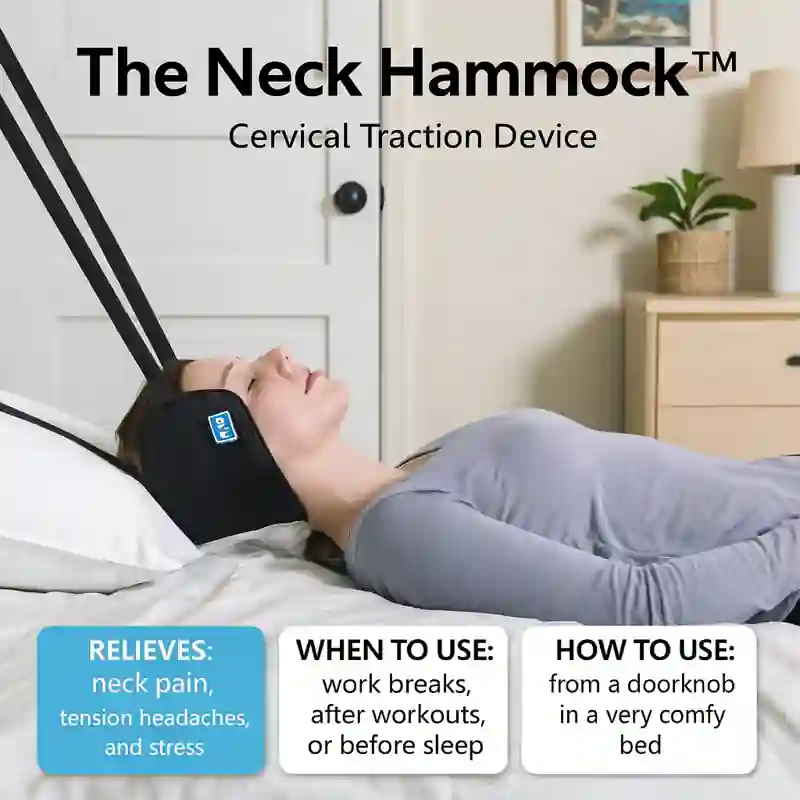
The Neck Hammock is a simple, portable traction tool that helps to strengthen the head and neck, relieve tension and restore comfort after long days. It gently supports your head and gently stretches your neck to relieve pain from sitting, typing, or staring at a screen. It is small, soft, and easy to take anywhere, making it the perfect neck traction pillow for home, work, or travel.
To use this traction device for instant neck relaxation, attach the strap to a sturdy doorknob or wall hook. Lie back, place your head in the sling and gently lift the hammock up. The stretching tension helps to relax the muscles, increase blood flow and correct the natural curve of your neck. Ten to fifteen minutes is enough to feel calm and relaxed.
This pillow for home use neck therapy focuses on the areas of the neck, shoulders, and upper back that are most stressed during the day. The soft fabric feels smooth on the skin, and the straps are easy to adjust to your height and comfort level. It’s washable, folds easily, and holds its shape well even after multiple uses.
People love this device because it’s lightweight and easy to use without the need for electricity or tools. It’s a practical option for quick neck care that fits anywhere in your routine. If it feels too tight, move closer to the anchor point or loosen the strap slightly. You can find these online or in most stores.
Pro tip: Use it on a solid surface and make sure the strap is secure before lying down. Start with short sessions, then increase the time slowly as your body adjusts. Keep it clean, store it dry, and it will stay soft and strong for a long time.
Pros
-
Lightweight and packable for home or travel use.
-
Requires minimal setup and no fixed equipment.
-
Supports gentle decompression and relaxation.
Cons
-
May not provide strong traction for users needing deeper lift.
Neck Stretcher with Neck Brace, Cervical Traction Neck Device
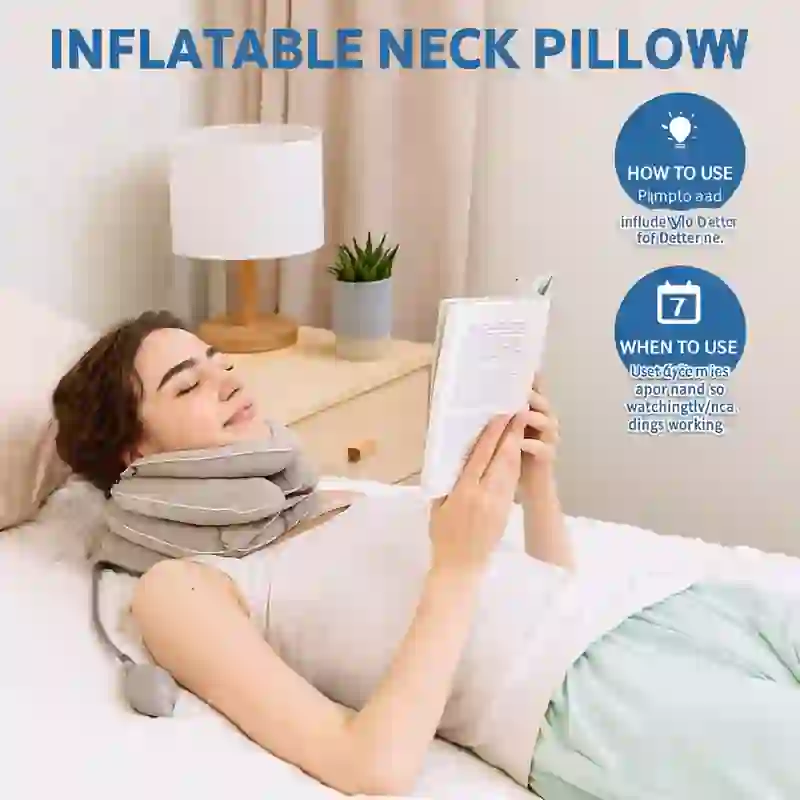
The Bkrtondsy inflatable neck traction apparatus is a soft air-filled collar made to relieve neck tension and improve comfort. It gently lifts the head to reduce pressure on the spine and muscles, helping you feel more relaxed after long hours at a desk or looking at screens. It’s light, comfortable, and easy to use every day.
To use it, place the collar around your neck and fasten the strap. Inflate it slowly using the hand pump until you feel gentle support not tightness. The air cushions lift the neck evenly, helping muscles loosen and improving posture. It’s great for short breaks, after work, or before bed when your neck feels sore or heavy.
This device focuses on the neck, shoulders, and upper back areas that often carry stress. The soft, smooth fabric feels pleasant on the skin, and the air chambers hold their shape well during use. It’s simple to clean and folds flat, so you can take it anywhere or store it easily in a drawer or bag.
People like this model for its simplicity and comfort. It doesn’t need electricity or complex setup just air and a few minutes of your time. If it feels too firm, release a little air until it fits comfortably. It’s available online and in most health or wellness stores across the country.
Pro tip: Start with short sessions of five to ten minutes. Inflate slowly until you feel light support, then stop. After each use, deflate fully, wipe clean, and keep it in a dry place to preserve the fabric and shape for daily use.
Pros
-
Provides stability and lift in one device.
-
Ideal for users who need structured neck positioning.
-
Adjustable straps allow for gradual tension control.
Cons
-
The firm fit may feel restrictive for users who prefer flexible designs.
AUVON Inflatable Neck Stretcher for Cervical Traction
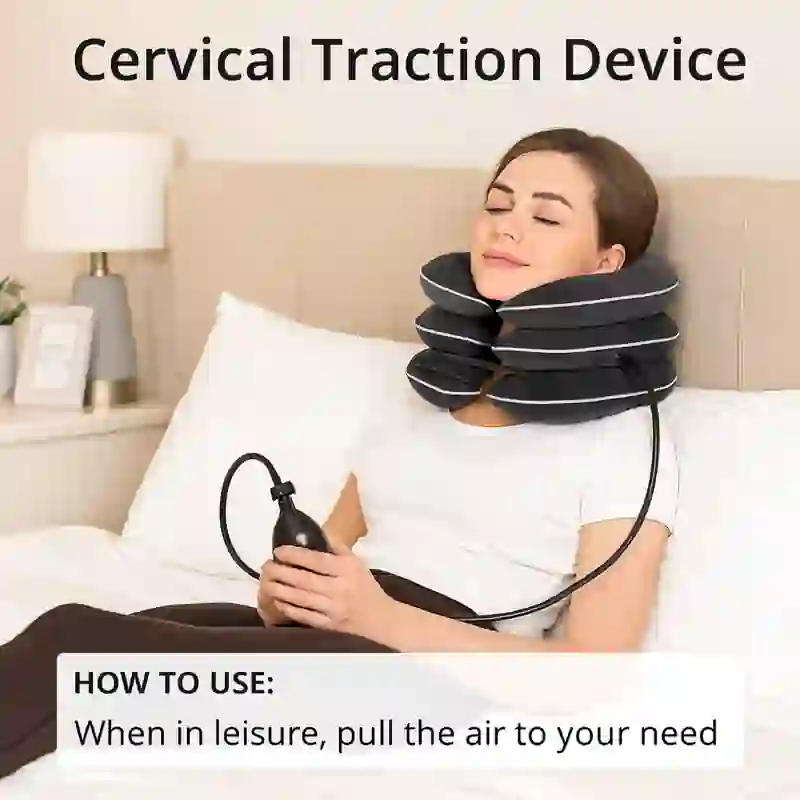
The AUVON inflatable cervical traction device is a soft, air-filled neck support that helps release stiffness and ease daily tension. It gently lifts the neck to reduce pressure on the spine, making it easier to relax after long hours at a computer or on your phone. Its simple, lightweight design makes it perfect for use anywhere at home, at work, or while traveling.
To use it, wrap the collar around your neck and adjust the strap until it feels comfortable. Slowly squeeze the hand pump to add air until you feel a gentle lift. The even pressure helps your muscles relax and restores balance in your neck and shoulders. Short sessions of five to ten minutes work best for relief and comfort.
This device targets the neck, upper back, and shoulders the areas that tend to tighten with daily stress. The soft fabric feels pleasant against the skin, and the air chambers stay firm while still offering flexibility. It’s easy to clean and folds flat, making it convenient to pack or store anywhere.
Many people like the AUVON device because it’s quiet, easy to adjust, and works without cords or power. You can change the air level anytime to match your comfort. If it feels too firm, just let out a bit of air. It’s available online and in most home wellness stores across the country.
Pro tip: Start slow and keep sessions short. Inflate it gently until you feel light support not tightness. Wipe it after each use and store it in a dry spot to keep it clean and soft. Avoid overinflating for the best comfort and safety.
Pros
-
Flexible inflation allows personalized traction levels.
-
Lightweight and travel-friendly design.
-
Soft materials offer comfort during extended wear.
Cons
-
Air pressure may gradually decrease and require occasional reinflation.
WANYIDA Neck and Shoulder Relaxer
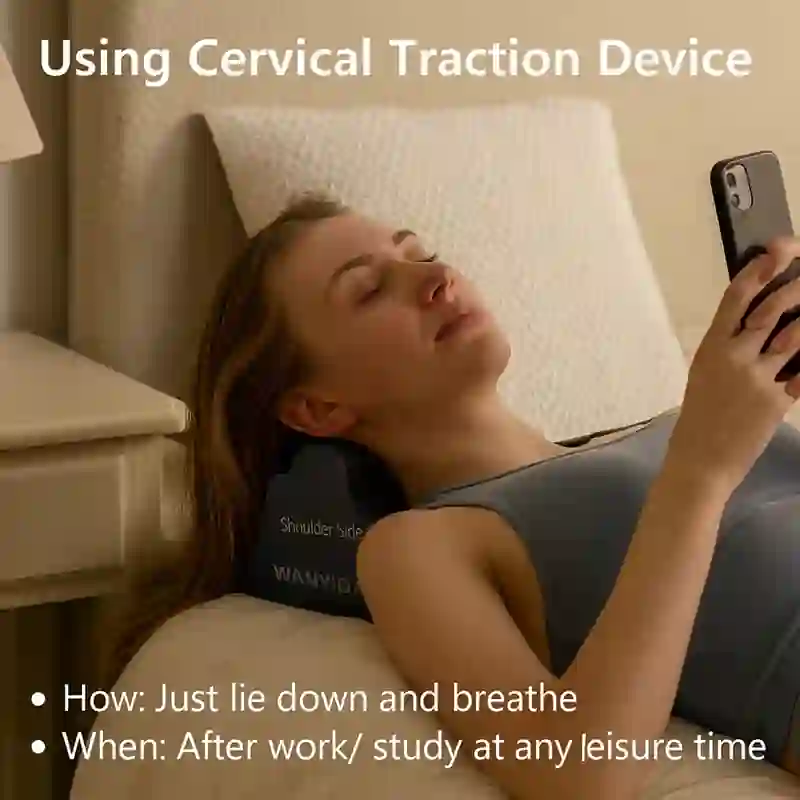
The WANYIDA neck and shoulder relaxer is a simple, firm support tool that helps calm sore muscles and ease tension after a long day. Its curved shape fits naturally around the neck, helping your head rest in a balanced position. It’s perfect for people who spend hours sitting at a desk, reading, or using a phone.
To use it, place the relaxer on a flat surface and lie down slowly so your neck rests in the middle curve. Let your head relax and stay still for five to ten minutes. The design gently stretches the neck and shoulders, helping reduce stiffness and improve comfort. It’s a quiet and easy way to unwind before bed or after work.
This relaxer focuses on the neck, shoulders, and upper spine the main areas that carry daily strain. The soft outer layer feels smooth on the skin, while the inside gives steady support. It’s lightweight, easy to carry, and simple to clean with a damp cloth. You can use it at home, at the office, or while traveling.
People like this product because it’s easy to use, requires no setup, and provides instant comfort. It works naturally no air, cords, or charging needed. If it feels too firm at first, place a small towel under it for added comfort. It’s available online and in most home wellness stores across the U.S.
Pro tip: Start with short sessions and slowly increase the time as your neck adjusts. Keep your body relaxed and breathe evenly while using it. Clean it after each session and store it in a cool, dry place so it lasts longer.
Pros
-
No straps or inflation required for use.
-
Supports natural neck curvature comfortably.
-
Suitable for short daily sessions of passive traction.
Cons
-
May not provide enough lift for users needing deeper decompression.
Chirp Wheel XR Massage Roller for Neck & Headache Relief
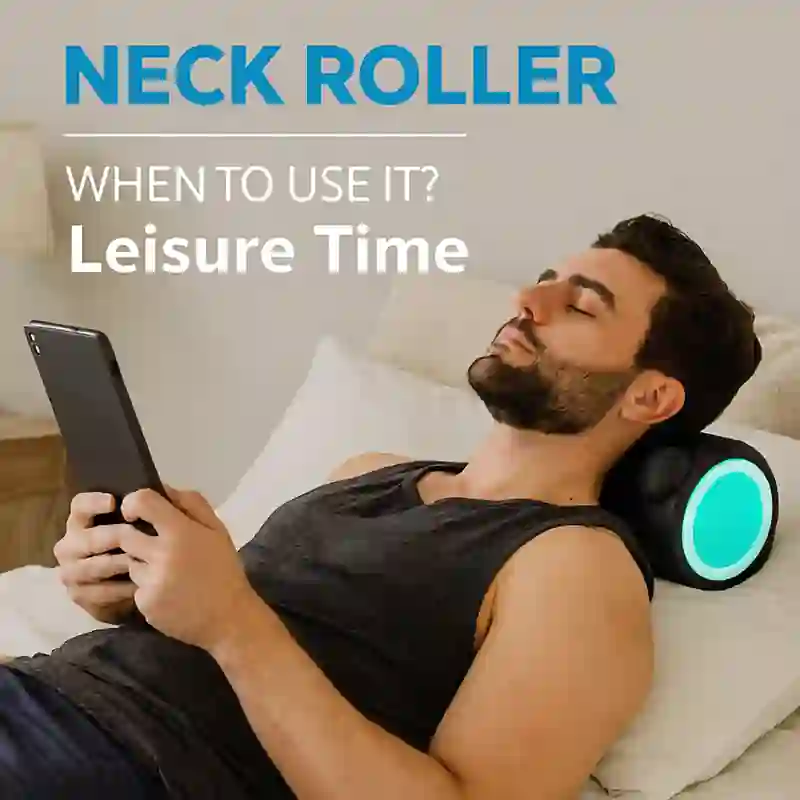
The Chirp deep-tissue foam roller is designed to help you relax and stretch tight muscles after long hours of sitting or exercise. Its smooth wheel shape fits the curve of your back and shoulders, helping release pressure and improve flexibility. It’s simple, lightweight, and easy to use for daily muscle care at home or on the go.
To use it, place the roller on the floor and lie back so it rests between your shoulder blades. Move slowly back and forth, letting your body weight create light pressure. This motion helps loosen knots, ease stiffness, and support healthy posture. You can also roll your legs or hips to relax sore muscles after workouts.
This roller focuses on the neck, shoulders, and back the areas most affected by sitting or standing too long. The outer surface is firm enough to provide relief but still cushioned for comfort. It’s durable, easy to clean, and small enough to fit into a gym bag or storage shelf. Regular use helps your body feel more flexible and relaxed.
People like this roller because it’s quick to use and brings fast results. It doesn’t need batteries or cords, just your body weight and a few minutes each day. If the pressure feels strong at first, place a towel underneath for a softer feel. It’s available online and in most wellness and fitness stores.
Pro tip: Begin with gentle rolling and increase time gradually. Aim for five to ten minutes a day for the best results. Clean it after each use and keep it in a dry spot so it stays in good condition for longer.
Pros
-
Combines traction-like stretch with massage benefits.
-
Effective for headache and neck tension relief.
-
Allows adjustable pressure using body weight.
Cons
-
Rolling motion may feel intense for users with severe stiffness.
Chirp Wheel Foam Roller
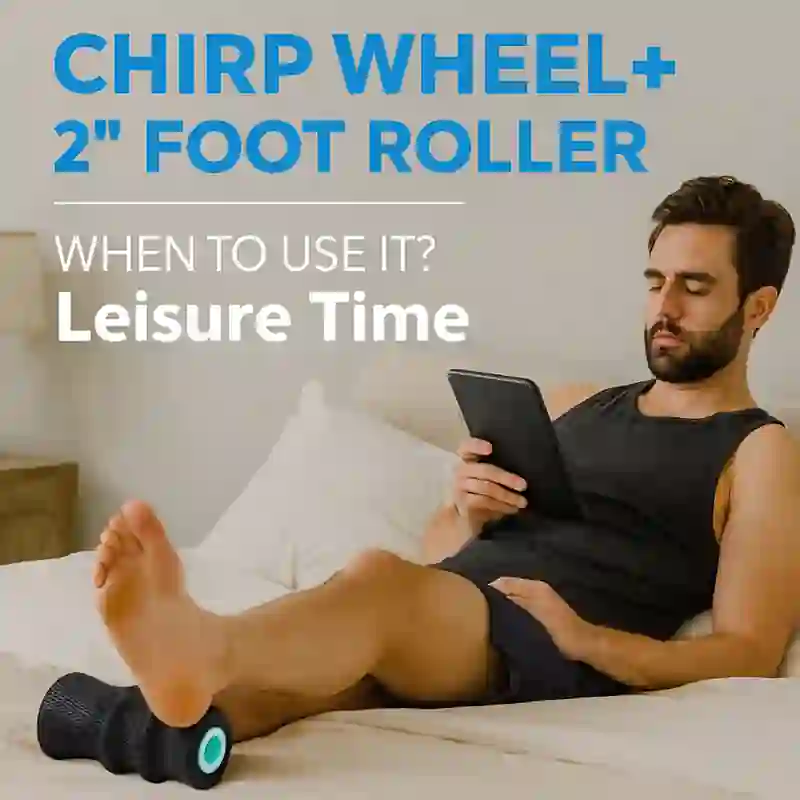
The Chirp deep-tissue foot massage roller helps relax tired feet after long hours of walking or standing. It’s built to fit the curve of your arch, giving a gentle rolling motion that eases tight muscles and improves blood flow. The smooth surface feels comfortable, and its small size makes it easy to use anywhere, anytime.
To use it, set the roller on the floor and move your foot back and forth slowly. This motion helps loosen the muscles in your arch and heel, easing pressure from daily activity. You can use it while sitting at your desk, watching TV, or before bed. Just a few minutes of rolling can make your feet feel light and relaxed.
This roller works best for the feet but can also help with overall relaxation. Its sturdy build offers steady pressure without being harsh. The outer layer feels smooth and is simple to wipe clean after each use. It’s strong enough for daily use and compact enough to keep in a drawer, bag, or gym locker.
People love this roller because it’s quick to use, quiet, and always ready. There’s no need for power or setup just roll and relax. If the pressure feels too firm, wear socks for extra comfort. It’s available online and in wellness stores across the United States.
Pro tip: Start slow and roll gently for a few minutes per foot. Add more time as your muscles adjust. Clean it after every use and keep it in a dry, cool place so it stays in great shape for years.
Pros
-
Targets muscle tension near the neck and upper spine.
-
Offers controlled pressure through body positioning.
-
Works well as a warm-up tool before traction.
Cons
-
Not ideal for users needing static traction without movement.
FitBeast Back Roller, Back Wheel Foam Roller
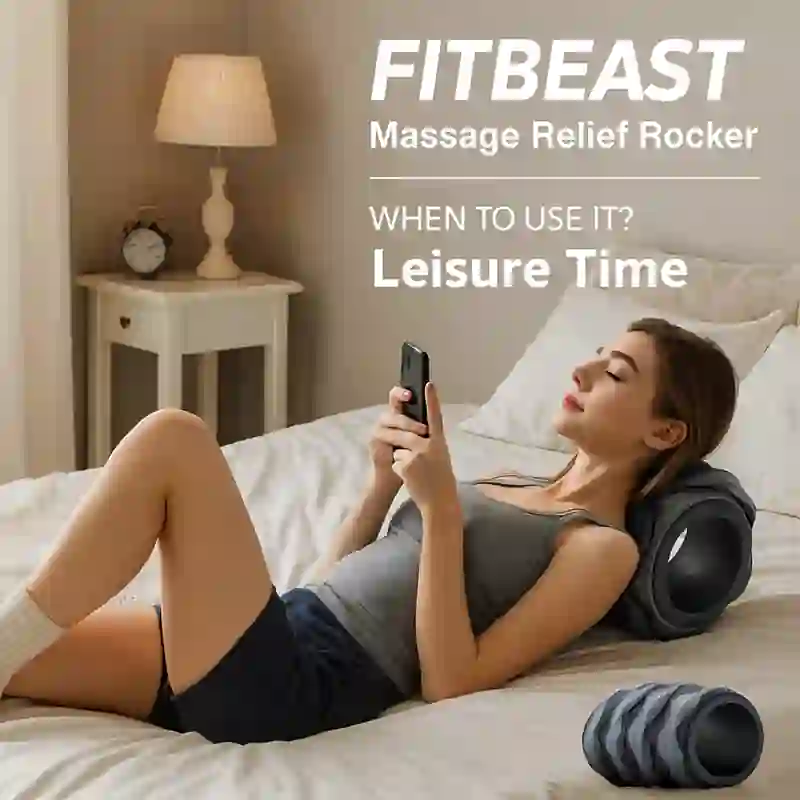
The FitBeast deep-tissue back roller is a simple, sturdy tool made to ease back tension and help you stretch comfortably at home. Its round shape fits the natural curve of your spine, helping release tight muscles and improve posture. It’s perfect for anyone who spends long hours sitting, driving, or working on a computer.
To use it, place the roller on the floor and slowly lie back so it rests between your shoulder blades. Roll gently up and down using your body weight to guide the pressure. This smooth motion loosens stiff muscles, improves movement, and helps your back feel lighter. It’s great to use after workouts or before bed to relax.
This roller focuses on the back, shoulders, and upper spine the areas that often carry daily stress. The outer surface feels soft but firm, giving steady pressure without hurting. It’s lightweight, easy to clean, and strong enough for everyday use. You can store it easily or take it along when traveling.
People like this roller because it brings quick comfort without needing any setup. There’s no battery or power required just roll at your own pace. If it feels too firm at first, place a towel under it for extra padding. You can find it online or at most wellness and sports stores across the country.
Pro tip: Begin with short sessions of slow rolling. Keep your breathing steady and relax your shoulders as you move. Wipe the roller after each use and keep it in a dry spot to make it last longer.
Pros
-
Supports both neck and back muscle release.
-
Adjustable pressure through rolling technique.
-
Helps improve spinal mobility and posture.
Cons
-
May be too intense for users with severe mid-back sensitivity.
Expert Buying Guide: How to Choose the Right Neck Traction Device for Home
Purpose: Pain Relief, Posture Correction, and Decompression Therapy
A neck traction apparatus helps release tension and restore movement. It gently stretches the neck muscles, reduces stiffness, and takes pressure off the spine. If your daily routine includes long hours on a computer or phone, regular use can help relax your neck and keep posture steady.
Type: Inflatable, Electric, Ergonomic Base, or Hammock-Style
Inflatable devices are easy to use and carry anywhere. Electric models offer steady pull with light heat for deep comfort. Ergonomic and hammock-style tools use body position and gravity to stretch the neck safely. Some home wellness neurobalance therapy use similar relaxation methods to support muscle recovery and calm tension.
Material: Foam vs. Plastic vs. Fabric Lining
Foam devices provide soft comfort and reduce pressure during short sessions. Plastic designs add firmness for better alignment. Fabric-lined inflatables balance comfort and flexibility, making them suitable for everyday use. Look for strong stitching and leak-proof valves to keep traction consistent and long-lasting.
Adjustability: Manual Knobs vs. Air Systems
Manual knob styles let you adjust pressure slowly and precisely. Air systems inflate evenly and work smoothly for beginners. Adjustable options are convenient for households or shared workspaces, since everyone can set their preferred comfort level easily.
Safety Tips: Gradual Traction, Doctor Consultation, and Proper Posture
Start with short sessions and light pressure. Increase traction gradually as your neck adjusts. If you have a medical condition, check with your doctor before using one. Keep your back straight, shoulders relaxed, and head aligned to prevent strain and get steady results.
For Urban Apartments or Small Home Offices
Compact traction tools work well in small homes and workspaces. Foldable and inflatable types save space and stay quiet. Cordless versions are easy to store and fit neatly into a daily routine, offering comfort without clutter or noise.
FAQ of Best neck traction device for home
What is the average cost of a neck traction device for home use?
Most neck traction tools are priced between $20 and $80, making them affordable for everyday use. Inflatable and foam types usually cost less, while heated or electric ones are slightly higher because of added comfort features. Each option offers good value and steady relief for home care.
Do higher-priced neck traction instruments give better results?
Not always. The real difference comes from comfort, fit, and ease of use, not just the price. Simple inflatable collars or foam relaxers can work as effectively as expensive versions. Higher-end models may add heating or cordless features, which make them more convenient but not necessarily more effective.
How good is the build quality of these neck traction tools?
These devices are made with soft, sturdy materials designed for daily use. Details like smooth fabric, strong stitching, and secure air valves ensure safety and comfort. Each one also comes with brand support and replacement service, giving users confidence in long-term use.
How does product delivery and support work?
You can easily buy these products online or from wellness stores. They come with fast delivery, helpful customer service, and warranty coverage. Homesdevice provides quick shipping and a low-price guarantee, ensuring that buyers receive dependable support and smooth delivery every time.
Are these neck traction units eco-friendly?
Yes. Most models are designed for manual or low-power use, which saves energy and cuts down waste. Their durable build and reusable materials make them long-lasting, helping reduce electronic waste while offering safe, everyday relief.
Which neck device is better for relief the pain?

Many users struggle with stiffness that goes beyond the cervical area alone. This roller helps relieve pressure along the thoracic spine, which often contributes to neck pain and restricted movement. The curved structure offers support while allowing users to adjust pressure using body weight, making it suitable for both light stretching and deeper release.
Final Thoughts
The best neck traction device for home can make a big difference in daily comfort. It gently stretches the neck, eases tightness, and helps you move without pain. Just a few minutes of use each day can reduce stiffness from long hours on your computer or phone and keep your neck feeling relaxed.
Using a traction device at home is simple and reliable. It’s quiet, easy to adjust, and fits naturally into your routine. Over time, it helps reduce tension, improve posture, and bring steady relief without needing regular clinic visits. It’s an easy habit that supports long-term comfort.
These tools are built for everyday life. Soft padding supports the neck, while air control makes setup quick and smooth. They’re light, easy to store, and perfect for small homes or workspaces. It’s a practical way to care for yourself gentle, effective, and ready when you need it.
Why Finding the Best Neck Traction Device for Home Fits the Homesdevice Lifestyle
At Homesdevice, we make it easy to find safe and reliable home products that work. Since 2022, we’ve helped homeowners, builders, and facility managers choose quality items that meet safety standards and fit their projects. From floor boxes to home power systems, every product is made for daily use and built to last.
We partner with trusted brands so you can shop with confidence. Each order comes with fast delivery, friendly support, and our 110% low price guarantee. Whether you’re updating a home office or adding smart features to your space, we’ll help you find what works best for your needs.
Visit Homesdevice to explore our full selection of home products. Our team is ready to answer questions, check code requirements, and make sure you get the right fit. Let us help you create a safe, efficient, and comfortable home with products you can trust.
As an Amazon Associate I earn from qualifying purchases.